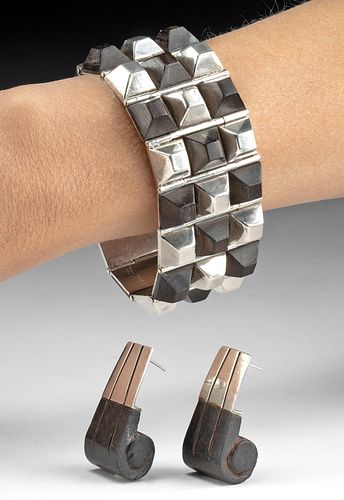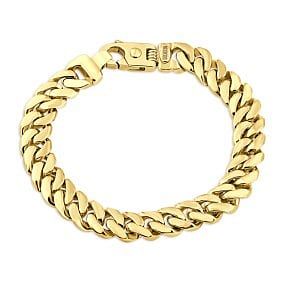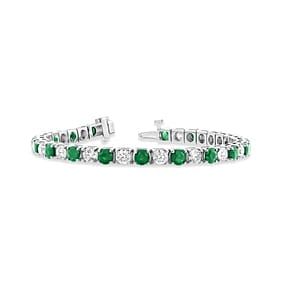20th C. Spratling Silver / Ebony Bracelet + Earrings
Lot 148
About Seller
Artemis Fine Arts
686 S Taylor Ave, Ste 106
Louisville, CO 80027
United States
Selling antiquities, ancient and ethnographic art online since 1993, Artemis Gallery specializes in Classical Antiquities (Egyptian, Greek, Roman, Near Eastern), Asian, Pre-Columbian, African / Tribal / Oceanographic art. Our extensive inventory includes pottery, stone, metal, wood, glass and textil...Read more
Categories
Estimate:
$2,400 - $3,600
Absentee vs Live bid
Two ways to bid:
- Leave a max absentee bid and the platform will bid on your behalf up to your maximum bid during the live auction.
- Bid live during the auction and your bids will be submitted real-time to the auctioneer.
Bid Increments
| Price | Bid Increment |
|---|---|
| $0 | $25 |
| $300 | $50 |
| $1,000 | $100 |
| $2,000 | $250 |
| $5,000 | $500 |
| $10,000 | $1,000 |
| $20,000 | $2,500 |
| $50,000 | $5,000 |
| $100,000 | $10,000 |
| $200,000 | $20,000 |
About Auction
By Artemis Fine Arts
Oct 21, 2021
Set Reminder
2021-10-21 10:00:00
2021-10-21 10:00:00
America/New_York
Bidsquare
Bidsquare : Fall Antiquities & Ethnographic Art Auction
https://www.bidsquare.com/auctions/artemis-gallery/fall-antiquities-ethnographic-art-auction-7725
Ancient art from Egypt, Greece, Italy and the Near East, as well as Asian, Fossils, Pre-Columbian, Native American, African / Tribal / Oceanic, Fine art, and much more! All categories, all price ranges... all legally acquired and guaranteed to be as described or your money back. Artemis Fine Arts info@artemisfinearts.com
Ancient art from Egypt, Greece, Italy and the Near East, as well as Asian, Fossils, Pre-Columbian, Native American, African / Tribal / Oceanic, Fine art, and much more! All categories, all price ranges... all legally acquired and guaranteed to be as described or your money back. Artemis Fine Arts info@artemisfinearts.com
- Lot Description
William Spratling (American, 1900-1967), Taxco, Mexico, ca. 1931 to 1946 CE. A beautiful sterling silver and ebony bracelet with matching earrings! The bracelet has a "pyramid style" with 14 rectangular silver panels, flat on the interior, with three pyramidal nodes of ebony and silver on the facing side. Each panel connects via a hinge that allows great flexibility. A chain attaches a pin for the clasp. The earrings have a unique spiral profile, a grooved top, then attach to a sterling silver post. Both bracelet and earrings are marked with the Spratling marks dating to the mid-20th century and reading "William Spratling Taxco Mexico" around a stylized W.S. with 92.5 printed above. Next to the maker mark is "TS-24" to indicate under the auspices of Sucesores de Spratling. Size of bracelet: 7.25" L x 1.375" W (18.4 cm x 3.5 cm); silver quality: 97% to 98%; weight: 98.5 grams; earrings: 1.375" L x 0.75" W (3.5 cm x 1.9 cm); silver quality: 93.3%; 11.9 grams
William Spratling made his initial visit to Mexico in 1926 and returned each summer for the next several years. Finally, in 1929, Spratling moved to Mexico becoming an active member of the vibrant artistic circles of Mexico. Spratling promoted the art of none other than Diego Rivera to New York galleries which led to Rivera's participation in the first exhibition of Mexican visual culture held in the United States, funded by the Carnegie Institute, that opened at the Metropolitan Museum of Art in New York. Not only did Spratling assist in curating the exhibition, but he also lent several his own pieces. During this same time period, Spratling was working on drawings for the expanding Morrow (US Ambassador to Mexico Dwight Morrow and his wife, the poet Elizabeth Cutter Morrow) home in Cuernavaca. Many of these drawings were included in the book written by Elizabeth Morrow entitled, "Casa Manana" (Knopf, 1930). It was Ambassador Morrow who suggested that Spratling explore developing the silver industry in Taxco.
Trying to find a way to support himself as an expatriate artist, Spratling took notice of the Taxco's silver-mining history and opened a workshop called the Taller de las Delicias, which translates to "Factory of Delights." Years later, he would write: "Nineteen-thirty-one was a notable year in modern Mexican silversmithing. A young silversmith from Iguala named Artemio Navarrete went to Taxco to work for a small silver shop, founded with the germ of an idea, where Artemio, as a nucleus, began to form silversmiths. The present writer, encouraged by his friends Moises Saenz, Dwight Morrow and Diego Rivera, had set up that little shop called 'Las Delicias.'"
Penny Chittim Morrill, Ph.D., who co-authored "Mexican Silver: 20th Century Hand-wrought Jewelry & Silver" with art dealer Carole Berk is the primary authority on Spratling's work. Morrill was the guest curator for the 2002 traveling exhibition entitled, "William Spratling and the Mexican Silver Renaissance: Maestros de Plata," organized by the San Diego Museum of Art. In her catalogue essay, Morrill stated, "In establishing silver as an artistic medium, what Spratling achieved was a delicate balance, a synthesis of abstract tendencies in the existent folk art tradition and in contemporary fine art, resulting in a visualization of concepts and ideas. As importantly, the Taller de las Delicias, became the paradigm for other silver designers to follow. Las Delicias was a community in which imagination and innovation were fostered and encouraged as the men learned the art of silversmithing while producing for profit. In the hierarchy of the workshop, these silversmiths advanced according to their ability, enthusiasm, and technical expertise."
Provenance: ex-private Moore collection, Denver, Colorado, USA, acquired prior to 1990
All items legal to buy/sell under U.S. Statute covering cultural patrimony Code 2600, CHAPTER 14, and are guaranteed to be as described or your money back.
A Certificate of Authenticity will accompany all winning bids.
PLEASE NOTE: Due to recent increases of shipments being seized by Australian & German customs (even for items with pre-UNESCO provenance), we will no longer ship most antiquities and ancient Chinese art to Australia & Germany. For categories of items that are acceptable to ship to Australia or Germany, please contact us directly or work with your local customs brokerage firm.
Display stands not described as included/custom in the item description are for photography purposes only and will not be included with the item upon shipping.
#162226Pin clasp is very stiff but does insert through all three catches. A professional jeweler might be able to adjust to make smoother entry. Minor surface wear and abrasions to ebony and silver pyramids on bracelet from use. Minor pressure fissure to wood verso of single earring that is not visible from frontside. Both earrings and bracelet are clearly stamped with Spratling marks. Professionally cleaned with some minor toning on silver. Earrings have backings and are ready to wear.Condition
- Shipping Info
-
All shipping is handled in-house for your convenience. Your invoice from Artemis Gallery will include shipping calculation instructions. If in doubt, please inquire BEFORE bidding for estimated shipping costs for individual items.
-
- Buyer's Premium



 EUR
EUR CAD
CAD AUD
AUD GBP
GBP MXN
MXN HKD
HKD CNY
CNY MYR
MYR SEK
SEK SGD
SGD CHF
CHF THB
THB













